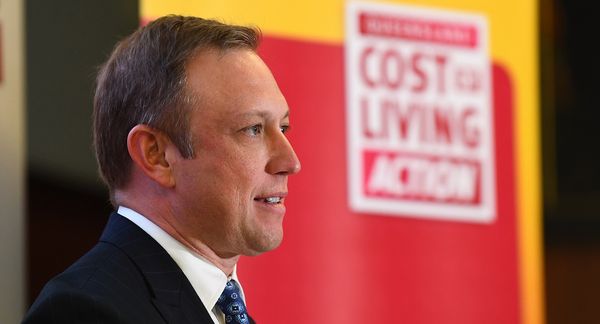
The Queensland treasurer, Cameron Dick, says the government made a “deliberate choice” to put the budget into deficit in order to fund a series of temporary cost-of-living measures ahead of the October election.
Heavy discounts will be applied to public transport fares, electricity bills and car registration fees in 2024/25, culminating in a $2.6bn deficit, the government announced in Tuesday’s budget. A “trial” plan for 50c public transport fares lasts only six months and will end three months after election day.
Dick said a family could receive as much as $10,000 in household relief under the budget measures. That includes rebates of $1,000 on power bills, and a 20% reduction in car registration costs. Other fees and charges will be frozen at current levels.
“Delivering a deficit, spending more than the government collects in revenue, is not, and should never be an easy choice,” Dick told parliament on Tuesday.
“But in a contest between the balance sheet and doing what matters for Queenslanders, the Miles Labor government will always be on Queenslanders’ side.
“Weak governments leave people to fend for themselves. Strong governments make the choice to intervene and invest.”
Dick also said the state was challenged by population growth, particularly from overseas migration. The premier, Steven Miles, said he continues to support federal moves to cut migrant numbers.
“We’ve been going through, and may still be going through the biggest influx of people the state has ever seen – a city the size of Mackay that no one saw coming,” Dick said.
Polling has suggested Labor was facing a heavy defeat in October, after almost 10 years in power, after the retirement of long-serving premier Annastacia Palaszczuk last year.
Dick repeatedly used the phrase “new government” and appeared to challenge the opposition leader, David Crisafulli, to vote against revenue measures in the parliament on Friday.
About $3.7bn in spending is temporary and will expire before the end of the next financial year.
Questioned about whether short-term measures were timed to coincide with the election, Dick told reporters he expected interest rates to fall in the near future, meaning measures to counter inflation would only be required temporarily.
But the budget papers warned of the risk that inflation could be “more persistent than expected”, which would delay rate cuts and hamper economic growth.
Two years ago, the state posted a record $13.93bn surplus, on the back of $10bn in additional revenue from controversial hikes to royalties.
The slide back into deficit has coincided with a crash in the metallurgical coal price, meaning royalties revert to prior rates. Next year, the state’s income from coal royalties will drop back below 2022/23 levels.
The budget also anticipates a 10.6% increase to health spending next year – a direct response to concern about hospital wait times, particularly in regional areas.
About $1.3bn has been for law and order spending, including funding for already-announced youth remand facilities, a new youth detention centre, 900 new police officers, measures to support victims of crime, and several other programs.
Queensland will spend $107.3bn on infrastructure – much of it to support energy transition – over four years.
Cost-of-living relief in the budget was designed to be non-inflationary – reductions in the cost of government services and charges, rather than measures that would put money into people’s pockets and back into the economy.
The government said it was also designed to target two areas – housing (including power) and transport, which together make up about a third of the typical household’s “basket of goods” used to calculate inflation.
Dick said construction costs had increased 31% over three years – affecting the budget by hampering infrastructure projects, and also contributing to a slowdown in the construction of new housing.
“That’s what we’ve had to manage since Covid,” Dick said.
“We made that clear decision not to cut but to invest in infrastructure.”
Treasury warned “construction activity has struggled to keep up with demand, significantly constrained by Covid-19-related material and labour shortages, poor weather and flooding, and construction company insolvencies.”










